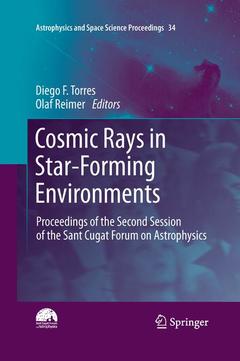Description
Cosmic Rays in Star-Forming Environments, 2013
Proceedings of the Second Session of the Sant Cugat Forum on Astrophysics
Astrophysics and Space Science Proceedings Series, Vol. 34
Language: English
Subject for Cosmic Rays in Star-Forming Environments:
Publication date: 05-2015
Support: Print on demand
Publication date: 05-2013
446 p. · 15.5x23.5 cm · Hardback
Description
/li>Contents
/li>Comment
/li>
These are the proceedings of the Sant Cugat Forum 2nd Workshop on Cosmic-ray Induced Phenomenology in Stellar Environments, held April 16-19, 2012. The aim of this Workshop was to address the current knowledge and challenges of high-energy emission from stellar environments at all scales and provide a comprehensive review of the state of the field from the observational to the theoretical perspectives. In the meeting, the prospects for possible observations with planned instruments across the multi-wavelength spectrum were analyzed and also how they impact on our understanding of these systems.
Prologue: γ-rays from star-forming regions, a historical perspective.- Cosmic rays in the interstellar medium.- The influence of cosmic rays in the circumnuclear molecular gas of NGC1068.- Star Formation in the Milky Way: The Infrared View.- The initial conditions of star formation: cosmic rays as the fundamental Regulators.- Cosmic-ray propagation in molecular clouds.- Distribution of Cosmic-Ray Ionization Rates in the Galactic Diffuse Interstellar Medium as Inferred from Observations of H+3, OH+, and H2O+.- Consequences of Starbursts for the Interstellar and Intergalactic Medium.- Stellar Populations in the Galactic Center.- The cosmic-ray dominated region of protoplanetary disks.- The central regions of local (U)LIRGs viewed with big radio eyes.- Evidence of nuclear disks from the radial distribution of CCSNe in starburst galaxies.- GeV gamma-ray emission from normal and starburst galaxies.- High Energy Emission from Star-Forming Galaxies.- Cosmic ray acceleration in W51C observed with the MAGIC telescopes.- Cosmic rays and molecular clouds.- Molecular and atomic gas in the young TeV γ-ray SNRs RX J1713.7−3946 and RX J0852.0−4622; evidence for the hadronic production of γ-rays.- New insights on hadron acceleration at supernova remnant shocks.- Cosmic rays in the Orion Bar.- The FIR-Radio Correlation in Rapidly Star-Forming Galaxies: The Spectral Index Problem & Proton Calorimetry.- A possible GeV-radio correlation for starburst galaxies.- Shock acceleration of relativistic particles in galaxy collisions.- Gamma-rays and neutrinos from dense environments of massive binary Systems.- Cosmic-ray-induced ionization in molecular clouds adjacent to supernova remnants.- The Consequences of the Interaction of Cosmic Rays with Galactic Center Molecular Clouds.- Traces of past activity in the Galactic Centre.- Fermi Bubble: Giant gamma-ray bubbles in the Milky Way.- The Fermi Bubbles and Galactic Centre Star Formation.- From 10 Kelvin to 10 TeraKelvin:Insights on the Interaction Between Cosmic Rays and Gas in Starbursts.- Cosmic ray driven dynamo in spiral galaxies.- Nonthermal X-rays from Low-Energy Cosmic Rays in the Arches Cluster Region.- The High Altitude Water ˇCerenkov (HAWC) TeV gamma ray Observatory.




